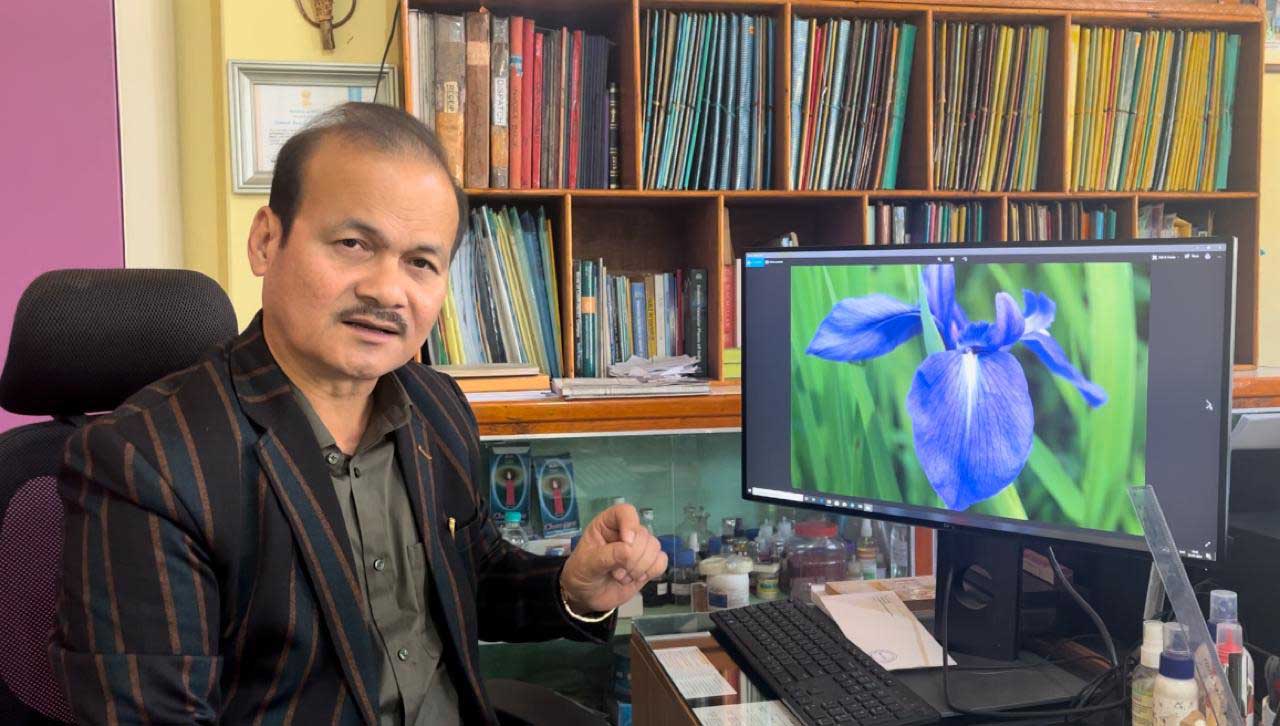Once abundantly blossoming and culturally significant to Meitei society, Manipuri Kombirei has been newly added to the Indian flora’s prized list. Development of its natural habitat would be the only feasible means for its propagation says chief scientist of Council of Scientific and Industrial Research-North East Institute of Science and Technology (CSIR-NEIST), Huidrom Birkumar Singh.
Manipuri Kombirei is considered to be a religiously associated flower for the Meitei society as it is mandatory for it to be included in the ceremonial offer on Sajibu Cheiraoba celebration (lunar New Year festival of Meitei community). However, as it has become rare to find real Manipuri Kombirei, people have substituting it with other exotic Iris variety on the Sajibu Cheiraoba.
Before knowing its botanical characteristic, this flower is almost on the verge of extinction. Nevertheless, as a result of consistent effort rendered by chief scientist of CSIR-NEIST Huidrom Birkumar Singh investigating about Manipuri Kombirei, the botanical identity of this plant has been established as Iris laevigata Fisch recently.
For many years, Huidrom Birkumar has been researching about real identity of Manipuri Kombirei. As an outcome of its study, Manipuri Iris or Iris laevigata Fisch was newly added in Indian flora as it has been reported first from Manipur in India. The finding was published recently in a journal called Indian Journal of Traditional Knowledge under the headlines Religiously associated Manipuri Kombirei (Iris laevigata Fisch.): A new addition to the Indian Flora.
In an interaction with Imphal Review of Arts and Politics, Huidrom Birkumar Singh said that his study on Manipuri Kombirei was started way back in 2000 by just collecting this particular species of Manipuri Kombirei. Sensing the fast extinction of Manipuri Kombirei, he began his full-on research on the said flora.
Stating that his worrisome in concern on vanishing Manipuri Kombirei, Iris laevigata Fisch before knowing its botanical identity, he said that though Manipuri Kombirei play significant role in Meitei society. But unfortunately, people offer this flower on auspicious day of Sajibu Cheiraoba for such a long time without knowing its exact character has stimulated him to identify it.
“I am so happy that at least our Manipuri Kombirei has been added to Indian flora though this beautiful flower is no longer seen unlike before. Twenty-one taxa of Iris are reported from the whole Himalayan region and 23 species from India. In other country like China and Japan this particular species of Irish laevigata Fisch are grown but in India it is endemic to Manipur. As such Manipuri Kombirei or Iris laevigata Fisch will be 24th species,” he informed.
Highlighting the present status on availability of Manipuri Kombirei Birkumar said that because of anthropogenic factor, natural habitat of Manipuri Kombirei has been lost. On top of this, climate change is also another key factor.
“During 1960’s Kombirei plant was naturally growing in two wetlands of Manipur namely, Lamphelpat and Yaralpat but now it has completely vanished from its natural habitat due to various factors like habitat loss and invasion by weeds but a few hundred plants are maintained in captive farm at the periphery of Lamphelpat by a private cultural society named as Ipathoukok. Currently, some plants are also recorded in small pockets from two wetlands of Manipur namely, Maibam Phumlou and Ikkop pat which is believed to have been established later by being brought down by the upstream rivers falling into the lakes,” he stated.
The Manipuri Kombirei or Manipuri Iris which is considered endemic to Manipur as per the Flora of Manipur (2000) has long been misidentified (misnomer) as Iris bakeri Wall. (Iridaceae) but now it is confirmed as Iris laevigata Fisch.
Birkumar clarified that a research publication of Botanical Survey of India, published in 1961, suspects the Kombirei or Manipuri Iris to be Iris bakeri Wall. but under investigation. Since then, the scientific name of the Kombirei plant has been used as Iris bakeri Wall. but it is found that Iris bakeri Wall. is misnomer and non-existent species.
Sharing about his studies on Manipuri Kombirei, he said that flowering plant specimens were collected from the farm of the Ipathoukok, Lamphelpat, Imphal. The collected flowering plant samples were used to prepare herbarium specimen(s) following standard methodology.
He continued and said that the herbarium specimen is preserved at CSIR-NEIST, Branch Laboratory, Lamphelpat, Imphal, Manipur and one specimen has been deposited in the ‘ASSAM’ Herbarium of the Botanical Survey of India, Eastern Circle, Shillong. The identity of this plant has been established as Iris laevigata Fisch. after thorough study of the plants, its flowers and other morphological structures. The identity of the plant was authenticated from the Royal Botanical Garden, Kew.
Manipuri Kombirei which is suitable only in marshy or boggy areas. In association with other line department, transplantation of Kombirei was carried out in Yaralapat but it was not success says Birkumar.
Clarifying the misconception, he said that real Manipuri Kombirei cannot grow in any other places except in marshy areas. Iris species that normally grow in Manipur at home or at garden are Iris sanguinea.
The species is endangered regionally and need to be conserved. If no proper conservation measures taken up urgently, the species may completely be vanished from the state and from India as well, he added while suggesting that developing a suitable habitat is need of hour as the said flower is ecologically too sensitive.










